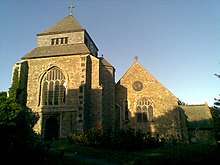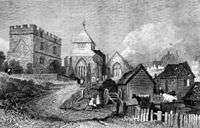Minster, Swale
Minster is a large village on the north coast of the Isle of Sheppey in the Minster-on-Sea civil parish and the Swale district of Kent, England.
| Minster on Sea | |
|---|---|
Minster Leas | |
 Minster on Sea Location within Kent | |
| Population | 14,789 (2011 Census)[1] |
| OS grid reference | TQ952729 |
| Civil parish | |
| District | |
| Shire county | |
| Region | |
| Country | England |
| Sovereign state | United Kingdom |
| Post town | SHEERNESS |
| Postcode district | ME12 |
| Dialling code | 01795 |
| Police | Kent |
| Fire | Kent |
| Ambulance | South East Coast |
| UK Parliament | |

Toponymy
The name of the town derives from the monastery founded in the area.[2] There is some variation in the use of the name, with the local parish council being named Minster-on-Sea,[3] while other sources, such as the local primary school, use Minster-in-Sheppey,[4] in order to distinguish it from Minster-in-Thanet, also in the county of Kent. Both places are listed in the Ordnance Survey gazetteer as Minster.[5] Royal Mail identifies a locality of Minster on Sea in the ME12 postcode district.[6] Minster-on-Sea is a location mentioned in Dickens's The Old Curiosity Shop.
Geography
The coast here consists of London Clay, and many fossil remains can be found along the beach after the waves have brought down the cliffs.
Religious sites

In around AD 670 King Ecgberht of Kent gave land at Minster for his mother Seaxburh of Ely to establish a Benedictine nunnery which was burnt down by the Danes in 855.[7] At some point before the Norman invasion the church was rebuilt and refounded as a Benedictine nunnery, incorporating elements of the original construction in the north chancel and nave.[8] Between 1123 and 1139 Archbishop Corbeil (Corbeuil) refounded it as an Augustinian nunnery. Corbeil is thought to be responsible for the unusual "semi-detached" arrangement of two churches next to each other, the Saxon church of the convent to the north and a parish church to the south for the villagers. They share a wall containing pointed arches and are now used as a single building. The abbey was dissolved in 1539 and along with Davington Priory near Faversham it came into the possession of Sir Thomas Cheney (Cheyney/Cheyne), a favourite of Anne Boleyn. He died in 1558 and was first buried in the chapel of Saint Katherine, which was demolished to allow construction of the east end of the chancel in 1581.
Today the remains of the old abbey gatehouse is a museum and the remaining tower is being restored.
Burials at the abbey
- Roger Northwode
- Sir Robert de Shurland
- Thomas Cheney
History
In the early 20th century the island was hit by speculative builders and Minster suffered equally with Sheerness. After the Second World War the population of the village had swollen "from about 250 people in 100 homes to 5,500 people in 1,800 homes". (taken from the external link)
During the Second World War the Shoeburyness Boom, which ran across the Thames Estuary to protect shipping from submarine attack, ran from Royal Oak Point (near Minster) to Shoeburyness in Essex.[9] A similar structure was built along the same alignment in the early 1950s to protect against Soviet submarines. The Royal Oak Point end of the boom was demolished in the 1960s.[10]
Education
Oasis Academy Isle of Sheppey is located over two sites in the area, and is the only secondary school on the Isle of Sheppey. In 2009 eleven pupils were hurt by the collapse of a heating duct during an exam at its predecessor, Minster College.[11]
Minster Cricket Club
Minster Cricket Club play at the Gilbert Hall facility near St. George's School. The club was established in 1931 and is the largest on the Isle of Sheppey, fielding four senior teams for Saturday league cricket. The club also have a junior section with U16, U14, U12 & soft ball teams, two midweek cricket teams and a Sunday team.[12]
Amenities
In January 2014 a Micropub, The Heritage, opened in the High Street of Halfway Houses, near Minster, in premises previously used as a post office.
Transport
The most recent proposal for a Thames Estuary Airport involves a manmade island just north of the village.
References
- "Civil Parish population 2011". Neighbourhood Statistics. Office for National Statistics. Retrieved 21 September 2016.
- Hasted, Edward (1798). The History and Topographical Survey of the County of Kent: Vol 6. Victoria County History Series. pp. 216–229.
- "Minster-on-Sea Parish Council". Kent Parish Councils website. Kent County Council. 2008. Retrieved 13 July 2008.
- "Minster-in-Sheppey Community Primary School". School website. 2008. Archived from the original on 18 February 2007. Retrieved 13 July 2008.
- "Gazetteer Search Results: Minster". Ordnance Survey. Retrieved 6 June 2010.
- Royal Mail (2004), Address Management Guide (4 ed.), Royal Mail Group
- D. Stuart Hammond. "Kent Post Roman History Timeline". Family Threads. Archived from the original on 23 September 2015. Retrieved 23 September 2015.
- "Houses of Benedictine nuns: The priory of Minster in Sheppey". British History Online. Retrieved 29 September 2015.
- Platt, Len (2017). Writing London and the Thames Estuary: 1576-2016. BRILL. p. 92. ISBN 9789004346666.
- Historic England. "Cold War defence boom, Pig's Bay, Shoeburyness, Southend-on-Sea (1021091)". National Heritage List for England. Retrieved 24 October 2017.
- Walker, Peter; Weaver, Matthew (12 May 2009). "Eleven pupils hurt after heating duct collapses during exam". The Guardian.
- "Minster Cricket Club".
External links
| Wikimedia Commons has media related to Minster, Isle of Sheppey. |
- Historic England. "Monument No. 420334". PastScape.
- Abbey website